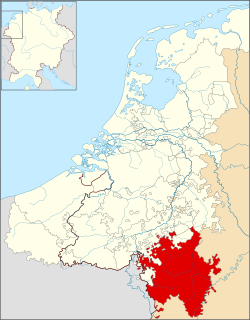Duchy of Luxembourg
| Duchy of Luxemburg | ||||||||||||
|
Herzogtum Lëtzebuerg (lb) Herzogtum Luxemburg (de) Duché de Luxembourg (fr) |
||||||||||||
|
State of the Holy Roman Empire Part of the Burgundian Netherlands (1443–1482) Part of the Habsburg Netherlands (1482–1581) Part of the Spanish Netherlands (1581–1700) Part of the Austrian Netherlands (1714–1795) |
||||||||||||
|
||||||||||||
|
||||||||||||
|
County of Luxembourg in 1350
|
||||||||||||
| Capital | Luxembourg | |||||||||||
| Languages | Luxembourgish, German, French | |||||||||||
| Religion | Catholic Church | |||||||||||
| Government | Feudal monarchy | |||||||||||
| Duke of Luxemburg | ||||||||||||
| • | 1353–1383 | Wenceslaus I (first) | ||||||||||
| • | 1415–1419 | Elizabeth of Görlitz | ||||||||||
| • | 1419–1425 | John the Fearless | ||||||||||
| • | 1425–1443 | Elizabeth of Gorlitz (last) | ||||||||||
| • | 1439–1482 | William III of Saxony (claimant) | ||||||||||
| Historical era | Middle Ages | |||||||||||
| • | Count Siegfried first mentioned |
963 | ||||||||||
| • | Acquired by Luxembourg dynasty |
1214 | ||||||||||
| • | Raised to duchy | 1353 | ||||||||||
| • | Held by the Dukes of Burgundy |
1443 | ||||||||||
| • | To Habsburg | 1482 | ||||||||||
| • | Occupied by France | 1795 | ||||||||||
| • |
Grand Duchy re-established |
1815 |
||||||||||
|
||||||||||||
The Duchy of Luxemburg (French: Luxembourg, Luxembourgish: Lëtzebuerg) was a state of the Holy Roman Empire, the ancestral homeland of the noble House of Luxembourg. The House of Luxembourg, now Duke of Limburg, became one of the most important political forces in the 14th century, competing against the House of Habsburg for supremacy in Central Europe. They would be the heirs to the Přemyslid dynasty in the Kingdom of Bohemia, succeeding the Kingdom of Hungary and contributing four Holy Roman Emperors until their own line of male heirs came to an end and the House of Habsburg got the pieces that the two Houses had originally agreed upon in the Treaty of Brünn in 1364.
In 1411, Sigismund of Luxembourg lost the duchy to his niece Elisabeth because he defaulted on a loan. Elizabeth later sold the duchy to the Duke of Burgundy, Philip the Good of the House of Valois-Burgundy, who paid her off in 1444. The dukes of Burgundy had previously acquired a number of other possessions in the Low Countries, including Flanders, Artois, Hainaut, Brabant, Zeeland, Holland, and Namur; Luxembourg and these other Burgundian possessions in the Low Countries are collectively referred to during this period (1384–1482) as the Burgundian Netherlands. The male line of the dukes of Burgundy died out in 1477 when Philip's son Charles the Bold died at the Battle of Nancy, leaving Mary of Burgundy, his only child, as his heiress. After his death, Mary married Archduke Maximilian I of the House of Habsburg, who later became Holy Roman Emperor. The Burgundian Netherlands then came under the rule of the House of Habsburg, beginning the period of the Habsburg Netherlands (1482–1581).
...
Wikipedia



